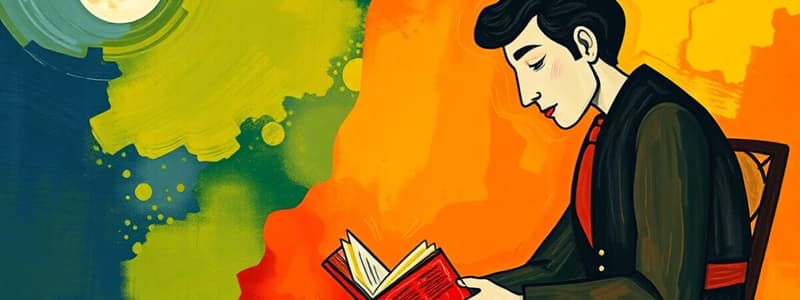Podcast
Questions and Answers
Which of the following is NOT an aspect of a story's setting?
Which of the following is NOT an aspect of a story's setting?
- Time
- Place
- Weather conditions
- Characterization (correct)
The antagonist is the central character in a story.
The antagonist is the central character in a story.
False (B)
What is the definition of 'characterization'?
What is the definition of 'characterization'?
The information the author gives the reader about the characters.
The plot is a logical series of events having a beginning, middle, and _____
The plot is a logical series of events having a beginning, middle, and _____
Which type of conflict is characterized by a struggle within a character?
Which type of conflict is characterized by a struggle within a character?
What is the theme of a story?
What is the theme of a story?
The moral of a story is the same as its theme.
The moral of a story is the same as its theme.
Match the type of character with its definition:
Match the type of character with its definition:
Flashcards are hidden until you start studying
Study Notes
Setting
- The setting is the time and location where a story takes place.
- Setting can be crucial to a story or inconsequential.
- Aspects of setting include the location, time period, weather, social conditions, and mood.
Character
- Character refers to both the person within a fictional work and their characteristics.
- In short stories, the protagonist is the central character, while the antagonist opposes them.
Characterization
- Characterization is the information the author provides about a character.
- It can be revealed through direct statements, physical appearance, dialogue, actions, thoughts, feelings, and how others interact with them.
Types of Characters
- Round Characters: Complex and multifaceted personalities like real people.
- Flat Characters: Briefly presented, lacking depth.
- Dynamic Characters: Change significantly by the end of the story.
- Static Characters: Stereotypical with limited unchanging characteristics.
Plot
- The plot is the organized sequence of events in a story.
- It has a beginning, middle, and end.
- Short stories typically have one plot to be consumed in a single sitting.
Conflict
- Conflict is essential to plot, driving the narrative forward.
- It’s any form of opposition faced by the main character.
- Conflict can be internal or external, and can include human vs. human, human vs. nature, human vs. society, and human vs. self.
Point of View
- Point of view is the perspective from which a story is told.
- Examples include:
- First Person
- Second Person
- Third Person: Omniscient, Limited Omniscient, Objective, Innocent Eye
Theme
- Theme is the underlying message or idea the author wants to convey.
- Examples include themes of bravery, perseverance, or love.
Moral
- Moral is a lesson the reader is expected to derive from a story.
- Examples include: "Pride comes before a fall" or "Think twice before you leap."
Studying That Suits You
Use AI to generate personalized quizzes and flashcards to suit your learning preferences.




